Discover 15 hidden attractions, cool sights, and unusual things to do in Lhasa (China). Don't miss out on these must-see attractions: Potala Palace, Jokhang Temple, and Sera Monastery. Also, be sure to include Drepung Monastery in your itinerary.
Below, you can find the list of the most amazing places you should visit in Lhasa (Tibet).
Table of Contents
Potala Palace
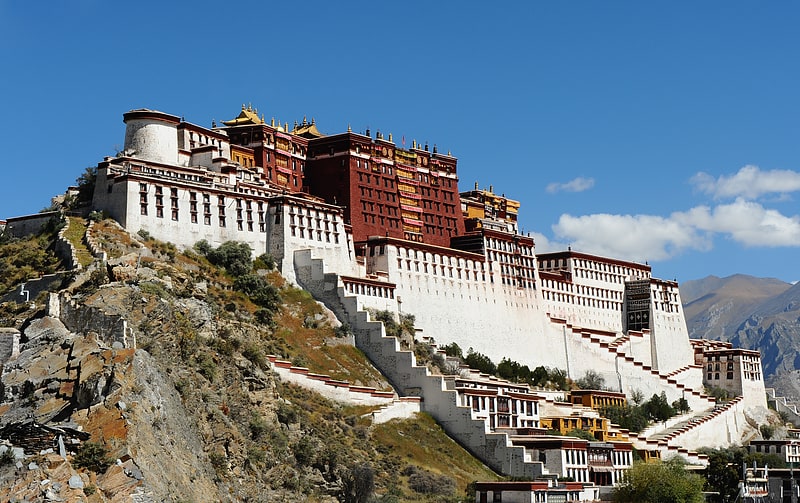
Also known as: 布达拉宫
Famed royal retreat from 17th century. The Potala Palace is a dzong fortress in the Lhasa, Tibet, China. It was the winter palace of the Dalai Lamas from 1649 to 1959, has been a museum since then, and has been a World Heritage Site since 1994.
The palace is named after Mount Potalaka, the mythical abode of the bodhisattva Avalokiteśvara. The 5th Dalai Lama started its construction in 1645 after one of his spiritual advisers, Konchog Chophel (died 1646), pointed out that the site was ideal as a seat of government, situated as it is between Drepung and Sera monasteries and the old city of Lhasa. It may overlay the remains of an earlier fortress called the White or Red Palace on the site, built by Songtsen Gampo in 637.
The building measures 400 metres (1,300 ft) east-west and 350 metres (1,150 ft) north-south, with sloping stone walls averaging 3 metres (9.8 ft) thick, and 5 metres (16 ft) thick at the base, and with copper poured into the foundations to help proof it against earthquakes. Thirteen storeys of buildings, containing over 1,000 rooms, 10,000 shrines and about 200,000 statues, soar 117 metres (384 ft) on top of Marpo Ri, the "Red Hill", rising more than 300 metres (980 ft) in total above the valley floor.
Tradition has it that the three main hills of Lhasa represent the "Three Protectors of Tibet". Chokpori, just to the south of the Potala, is the soul-mountain (Wylie: bla ri) of Vajrapani, Pongwari that of Manjusri, and Marpori, the hill on which the Potala stands, represents Avalokiteśvara.[1]
Address: 35 Beijing M. Rd., Lhasa
Jokhang Temple

Also known as: 大昭寺
Buddhist temple with a hallowed shrine. The Jokhang, also known as the Qoikang Monastery, Jokang, Jokhang Temple, Jokhang Monastery and Zuglagkang, is a Buddhist temple in Barkhor Square in Lhasa, the capital city of Tibet Autonomous Region of China. Tibetans, in general, consider this temple as the most sacred and important temple in Tibet. The temple is currently maintained by the Gelug school, but they accept worshipers from all sects of Buddhism. The temple's architectural style is a mixture of Indian vihara design, Tibetan and Nepalese design.
The Jokhang was founded during King Songtsen Gampo's reign of the Tibetan Empire. According to tradition, the temple was built for the king's two brides: Princess Wencheng of the Chinese Tang dynasty and Princess Bhrikuti of Nepal. Both are said to have brought important Buddhist statues and images from China and Nepal to Tibet, which were housed here, as part of their dowries. The oldest part of the temple was built in 652. Over the next 900 years, the temple was enlarged several times with the last renovation done in 1610 by the Fifth Dalai Lama. Following the death of Gampo, the image in Ramcho Lake temple was moved to the Jokhang temple for security reasons. When King Tresang Detsen ruled from 755 to 797, the Buddha image of the Jokhang temple was hidden, as the king's minister was hostile to the spread of Buddhism in Tibet. During the late ninth and early tenth centuries, the Jokhang and Ramoche temples were said to have been used as stables. In 1049 Atisha, a renowned teacher of Buddhism from Bengal taught in Jokhang.
Around the 14th century, the temple was associated with the Vajrasana in India. In the 18th century the Qianlong Emperor of the Qing dynasty, following the Gorkha-Tibetan war in 1792, did not allow the Nepalese to visit this temple and it became an exclusive place of worship for the Tibetans. During the Chinese development of Lhasa, the Barkhor Square in front of the temple was encroached. During the Cultural Revolution, Red Guards attacked the Jokhang temple in 1966 and for a decade there was no worship. Renovation of the Jokhang took place from 1972 to 1980. In 2000, the Jokhang became a UNESCO World Heritage Site as an extension of the Potala Palace (a World Heritage Site since 1994). Many Nepalese artists have worked on the temple's design and construction.[2]
Address: Barkhor Street, Chengguan District, 850000 Lhasa
Sera Monastery
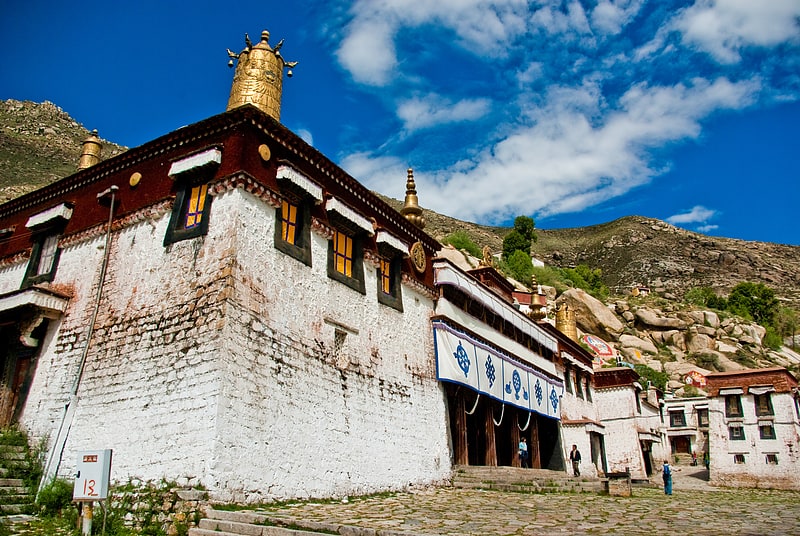
Also known as: 色拉寺
Giant, ancient Tibetan Buddhist complex. Sera Monastery is one of the "great three" Gelug university monasteries of Tibet, located 1.25 miles north of Lhasa and about 5 km north of the Jokhang. The other two are Ganden Monastery and Drepung Monastery. The origin of its name is attributed to a fact that during construction, the hill behind the monastery was covered with blooming wild roses.
The original Sera Monastery is responsible for some 19 hermitages, including four nunneries, which are all located in the foot hills north of Lhasa.
The Sera Monastery, as a complex of structures with the Great Assembly Hall and three colleges, was founded in 1419 by Jamchen Chojey of Sakya Yeshe of Zel Gungtang (1355–1435), a disciple of Je Tsongkhapa. During the 1959 revolt in Lhasa, Sera monastery suffered severe damage, with its colleges destroyed and hundreds of monks killed. After the Dalai Lama took asylum in India, many of the monks of Sera who survived the attack moved to Bylakuppe in Mysore, India. After initial tribulations, they established a parallel Sera Monastery with Sera Me and Sera Je colleges and a Great Assembly Hall on similar lines to the original monastery, with help from the Government of India. There are now 3000 or more monks living in Sera, India and this community has also spread its missionary activities to several countries by establishing Dharma centres, propagating knowledge of Buddhism.
Sera Monastery in Tibet and its counterpart in Mysore, India are noted for their debate sessions.[3]
Address: Wuze Hill , Sera, 850000 Lhasa
Drepung Monastery
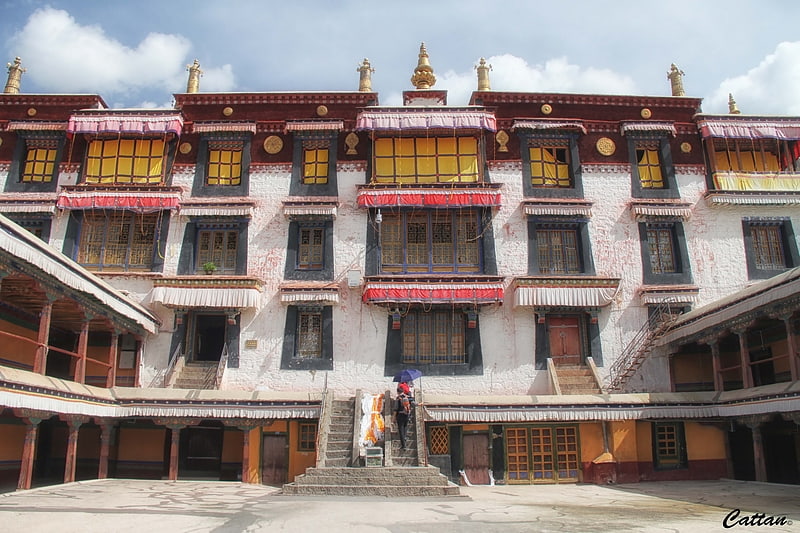
Also known as: 哲蚌寺
Buddhist temple and monastery complex. Drepung Monastery, located at the foot of Mount Gephel, is one of the "great three" Gelug university gompas of Tibet. The other two are Ganden Monastery and Sera Monastery.
Drepung is the largest of all Tibetan monasteries and is located on the Gambo Utse mountain, five kilometers from the western suburb of Lhasa.
Freddie Spencer Chapman reported, after his 1936–37 trip to Tibet, that Drepung was at that time the largest monastery in the world, and housed 7,700 monks, "but sometimes as many as 10,000 monks."
Since the 1950s, Drepung Monastery, along with its peers Ganden and Sera, have lost much of their independence and spiritual credibility in the eyes of Tibetans since they operate under the close watch of the Chinese security services. All three were re-established in exile in the 1950s in the state of Karnataka in south-west India. Drepung and Ganden are in Mundgod and Sera is in Bylakuppe.[4]
Norbulingka
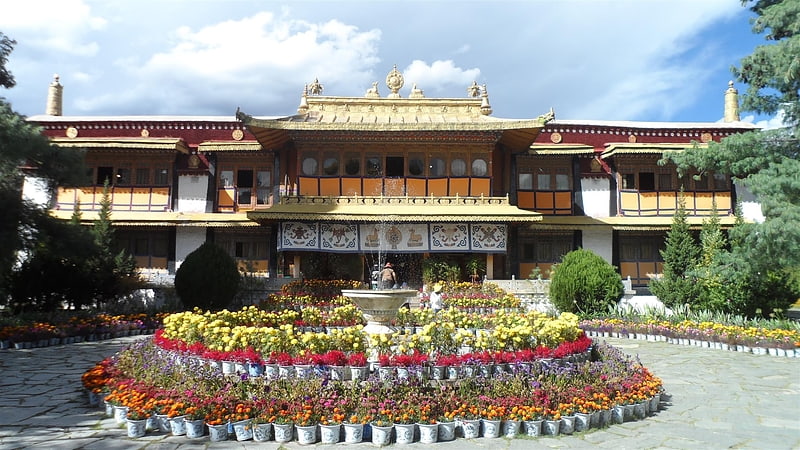
Also known as: 罗布林卡
Palace in Lhasa, Tibet. Norbulingka is a palace and surrounding park in Lhasa, Tibet, China, built from 1755. It served as the traditional summer residence of the successive Dalai Lamas from the 1780s up until the 14th Dalai Lama's exile in 1959. Part of the "Historic Ensemble of the Potala Palace", Norbulingka is recognized as a UNESCO World Heritage Site, and was added as an extension of this Historic Ensemble in 2001. It was built by the 7th Dalai Lama and served both as administrative centre and religious centre. It is a unique representation of Tibetan palace architecture.
Norbulingka Palace is situated in the west side of Lhasa, a short distance to the southwest of Potala Palace. Norbulingka covers an area of around 36 hectares (89 acres) and considered to be the largest man-made garden in Tibet.
Norbulingka park is considered the premier park of all such horticultural parks in similar ethnic settings in Tibet. During the summer and autumn months, the parks in Tibet, including the Norbulinga, become hubs of entertainment with dancing, singing, music and festivities. The park is where the annual Sho Dun or 'Yoghurt Festival' is held.
The Norbulingka palace has been mostly identified with the 13th and the 14th Dalai Lamas who commissioned most of the structures that still stand today. During the invasion of Tibet in 1950, a number of buildings were damaged, but were rebuilt beginning in 2003, when the Chinese government initiated renovation works here to restore some of the damaged structures, and also the greenery, the flower gardens and the lakes.[5]
Ramoche Temple
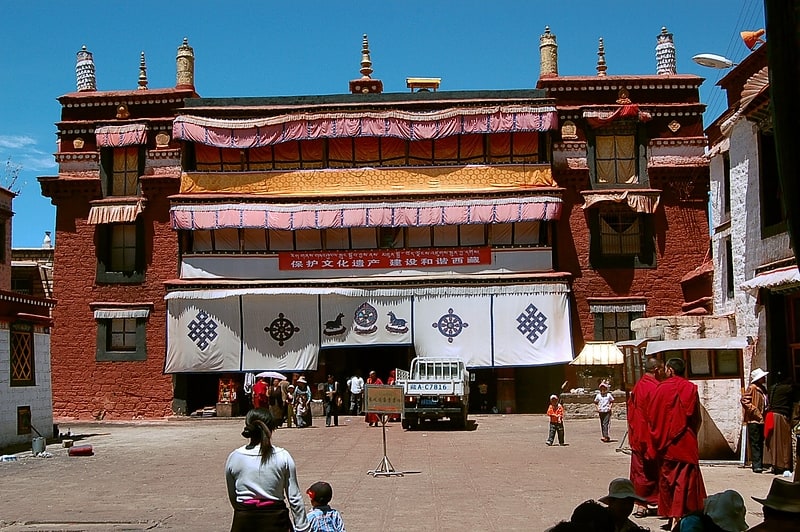
Also known as: 小昭寺
Ancient Buddhist temple. Ramoche Temple is a Buddhist monastery in Lhasa, Tibet Autonomous Region. It dates back to the seventh century and is considered to be the most important temple in the city after the Jokhang Temple. Situated in the northwestern part of the Tibetan capital, it is east of the Potala and north of the Jokhang. The site occupies an area of 4,000 square meters.[6]
Tibet Museum
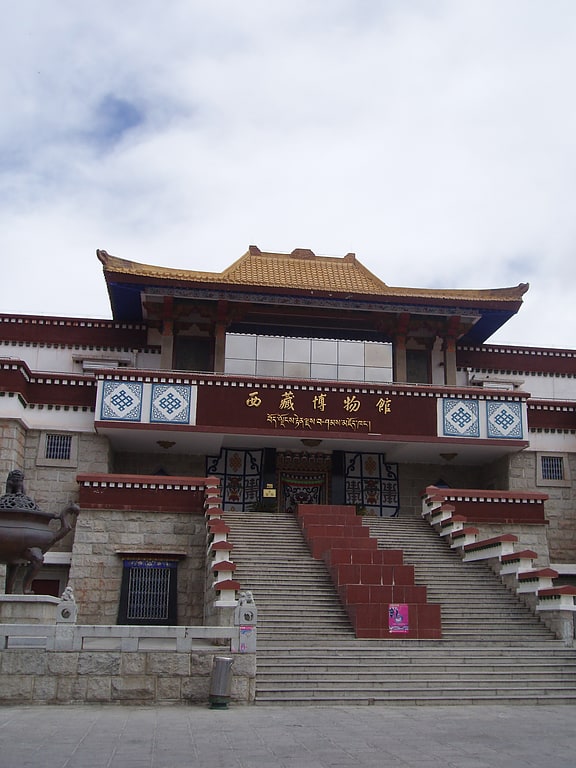
Also known as: 西藏博物馆
Museum in Lhasa, China. The Tibet Museum is the official museum of the Tibet Autonomous Region of China in Lhasa. Inaugurated on October 5, 1999, it is the first large, modern museum in the Tibet Autonomous Region. It has a collection of more than 520,000 artifacts, including pottery, jade, and Buddha statues, attracting hundreds of thousands of visitors every year. It has a collection of around 1,000 artifacts permanently on display related to the cultural history of Tibet, from examples of Tibetan art to architectural design throughout history such as Tibetan doors and beams. In order to fill the museum the Tibet aristocracy and religious establishment had their property confiscated by the Chinese Government.[7]
Address: 19 Luobulinka Rd, 850000 Lasa Shi
Kundeling Monastery

Also known as: 功德林寺
Monastery. Kundeling Monastery is a Tibetan Buddhist monastery in Lhasa, Tibet, China. It was founded around 1794, and follows the Gelug school. The head of the monastery belongs to a lineage of incarnations that dates back to 1402. There is dispute over the current incarnation. The monastery was destroyed during the Cultural Revolution, then rebuilt in the 1980s.[8]
Chagpori
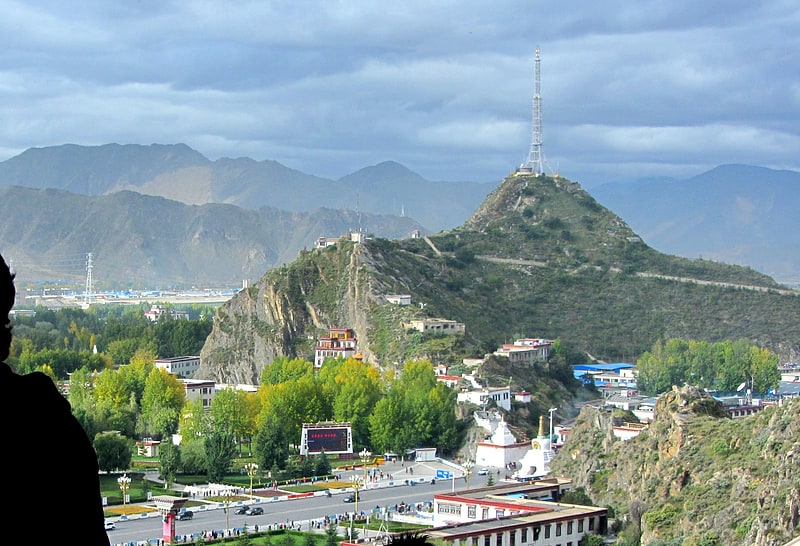
Also known as: 药王山
Mountain. Chagpori, Chakpori, Chokpori, Chagpo Ri (Wylie: lcags po ri, literally "Iron Mountain"; is a spirit-mountain of Vajrapani within the city of Lhasa in Tibet. It south of the Potala and just to the left when one is facing the Potala. It is considered to be one of the four holy mountains of central Tibet.
Chagpori was the site of the monastic medical college of the same name founded there by Sangye Gyatso in 1696. This medical college, which incorporated a recently restored temple made by Thang Tong Gyalpo, was supplied with revenue generating lands and with a constant stream of students by a "monk tax". It remained an important medical institution in Tibet and Central Asia up until the mid-Twentieth century. Peter Aufschnaiter was photographed by Heinrich Harrer on top of the College of Medicine (Men-Tsee-Khang) using a theodolite for surveying the city of Lhasa. Aufschnaiter wrote, "Since 23 December 1947 I have been staying in Lhasa for some months to make a town plan, and have now been appointed to the government service by a decree of the Regent."
During the March 1959 Lhasa uprising, the medical school established by the Thirteenth Dalai Lama named Men-Tsee-Khang and a temple housing statutes of coral (Tsepame), mother-of-pearl (of Tujechempo) and turquoise (of Drolma) were demolished by the People's Liberation Army artillery as the Tibetans had placed a few cannons up there. Jianglin Li's book Tibet in Agony: Lhasa 1959 says,
"On March 20 (...) That was the morning of the shelling of Chakpori Hill. While the Tibetan Medical Institute crumbled..."
The monk Jampa Phuntsok of the Namgyal Monastery recalled,
"when the bombardment of Chakpori Hill began (...) the Tibetans at the Potala could only watch as their beloved landmark went up in smoke."
It is now crowned by radio antennas. A road has been constructed through the spur that used to connect Chagpori with the Marpori ('Red Hill') on which the Potala is built. At this spur connecting these two hills was the famous chorten Pargo Kaling, a spired reliquary with an arch that served as the town's western gate and was demolished in 1967 and rebuilt in 1995.
Some rebuilding has since taken place a number of old rock carvings have survived through damage. Some of them are thought to have been carved during the reign of king Songtsen Gampo (605 or 617? - 649 CE) and painted by Nepalese artists. Some buildings have been rebuilt near the base of the hill and there is now again a small temple with prayer wheels.
Tradition has it that the three main hills of Lhasa represent the "Three Protectors of Tibet." Chagpori is the soul-mountain (bla-ri) of Vajrapani, Pongwari that of Manjushri, and Marpori, the hill on which the Potala stands, represents Chenresig or Avalokiteshvara.[9]
Muru Nyingba Monastery
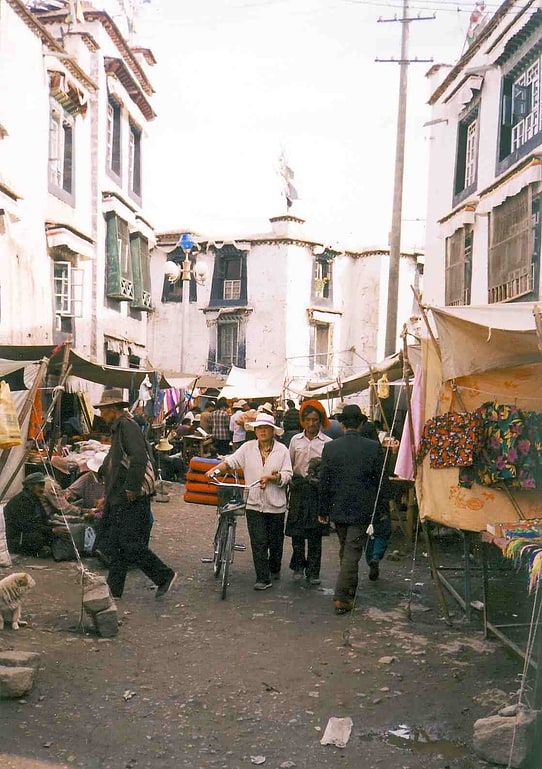
Also known as: 木如宁巴寺
Monastery. Muru Ningba or Meru Nyingba is a small Buddhist monastery located between the larger monasteries of Jokhang and Barkhor in the city of Lhasa, Tibet, China. It was the Lhasa seat of the former State Oracle who had his main residence at Nechung Monastery.
It is located immediately behind and east of the Jokhang and may be accessed from the north side of the Barkhor.[10]
Nechung
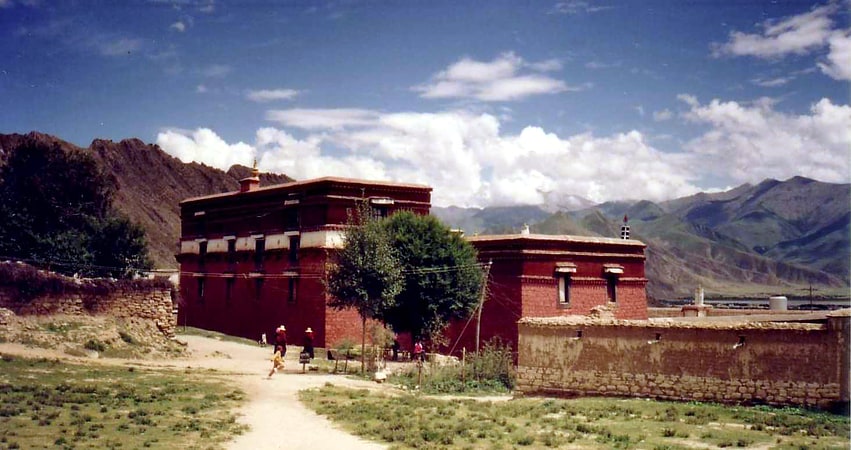
Also known as: 乃琼寺
Monastery. Nechung Monastery, Nechung Gompa or Nechung Chok, is the seat of the State Oracle of Tibet. It is also referred to as Sungi Gyelpoi Tsenkar, the "Demon Fortress of the Oracle King."
It is about 10 minutes walk down from Drepung Monastery, and was the residence of the three-headed, six-armed Pehar, the chief protector of the Gelugs (Yellow Hat sect) and the seat of the State Oracle or Nechung Oracle. It is a medium-sized temple which used to house about a hundred monks.[11]
Monument to the Peaceful Liberation of Tibet

Also known as: 西藏和平解放纪念碑
Tourist attraction in Lhasa, China. The Monument to the Peaceful Liberation of Tibet stands in the southern part of the Potala square in Lhasa, just outside the protective zone and buffer zone of the World Heritage Site. It celebrates what the People's Republic of China calls the Peaceful Liberation of Tibet by the People's Liberation Army, or what the exiled Tibetan government and the rest of the international community call the invasion and annexation of Tibet. The foundation stone was laid on July 18, 2001 by Hu Jintao, China's vice-president at the time. The monument was unveiled on May 22, 2002.
The US $1.7 million, 37-meter-high spire-like concrete structure was designed by Professor Qikang of the Southeast University in Nanjing, China. The monument abstractly portrays Mount Everest). The monument bears its own name engraved in the calligraphy of former general secretary and president Jiang Zemin, while an inscription refers to the expelling of "imperialist" forces from Tibet in 1951 (a reference to long-running Anglo-Russian Great-Game designs on the region) and reports on the socio-economic development achieved since then.
When apprised of the plans to build the memorial, the Tibetan government in exile claimed that "the monument would serve as a daily reminder of the humiliation of the Tibetan people." Kate Saunders, then spokeswoman for International Campaign for Tibet, said the construction in this sensitive spot is a political message to Tibetans about Chinese rule over the region.[12]
Tsomon Ling
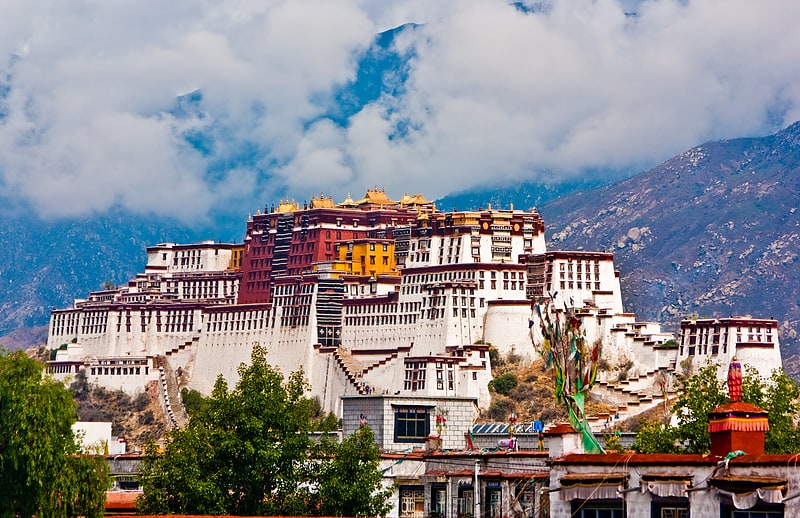
Also known as: 策墨林寺
Tsomon Ling, Tsomonling, Tsome Ling, Chomoling is a temple in inner Lhasa, Tibet Autonomous Region, China, south of the Ramoche Temple, and on the corner of one of the main roads, Dekyi Shar Lam. It was one of the Four Royal Colleges or Regency Temples of Lhasa built during the 17th century after the Fifth Dalai Lama assumed both temporal as well as spiritual power. The other three Ling are Tengye Ling, Kunde Ling, and Drib Tsemchok Ling.[13]
Trode Khangsar
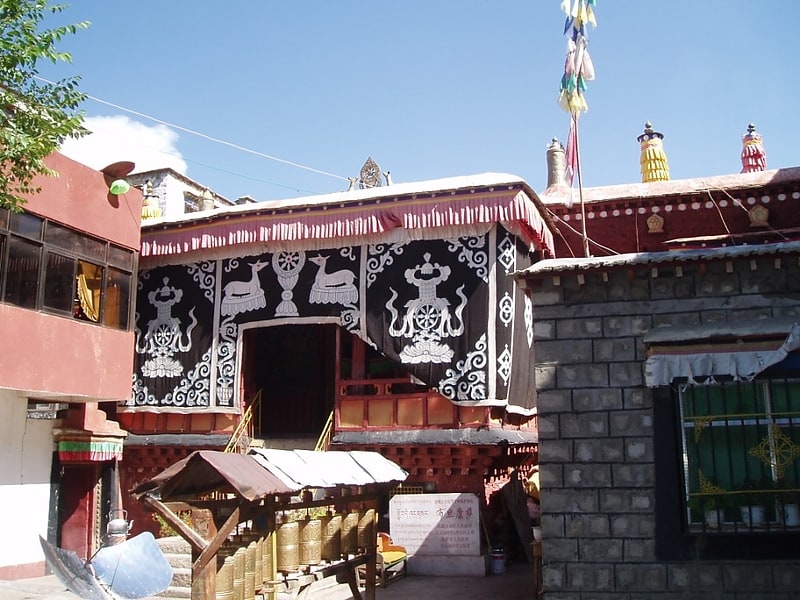
Also known as: 布旦康萨
Temple in Lhasa, China. Trode Khangsar is a temple located in Lhasa, Tibet Autonomous Region, China, that is over 300 years old. The temple is dedicated to the protector Dorje Shugden and has been traditionally managed by the Gelug monastery Riwo Chöling, which is located in the Yarlung valley.[14]
Ani Tsankhung Nunnery
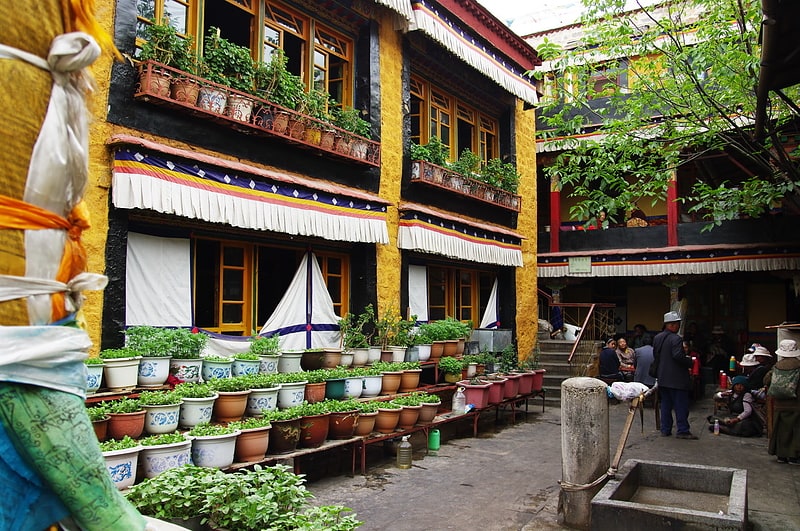
Also known as: 阿尼仓空寺
Ani Tsankhung Nunnery is a nunnery of the Gelug school of Tibetan Buddhism in the city of Lhasa, Tibet Autonomous Region, China. It was built in the 15th century on a site that had been used for meditation by the 7th century Tibetan king Songtsen Gampo. The nuns support themselves through alms and manufacturing items such as clothing and printed texts.[15]